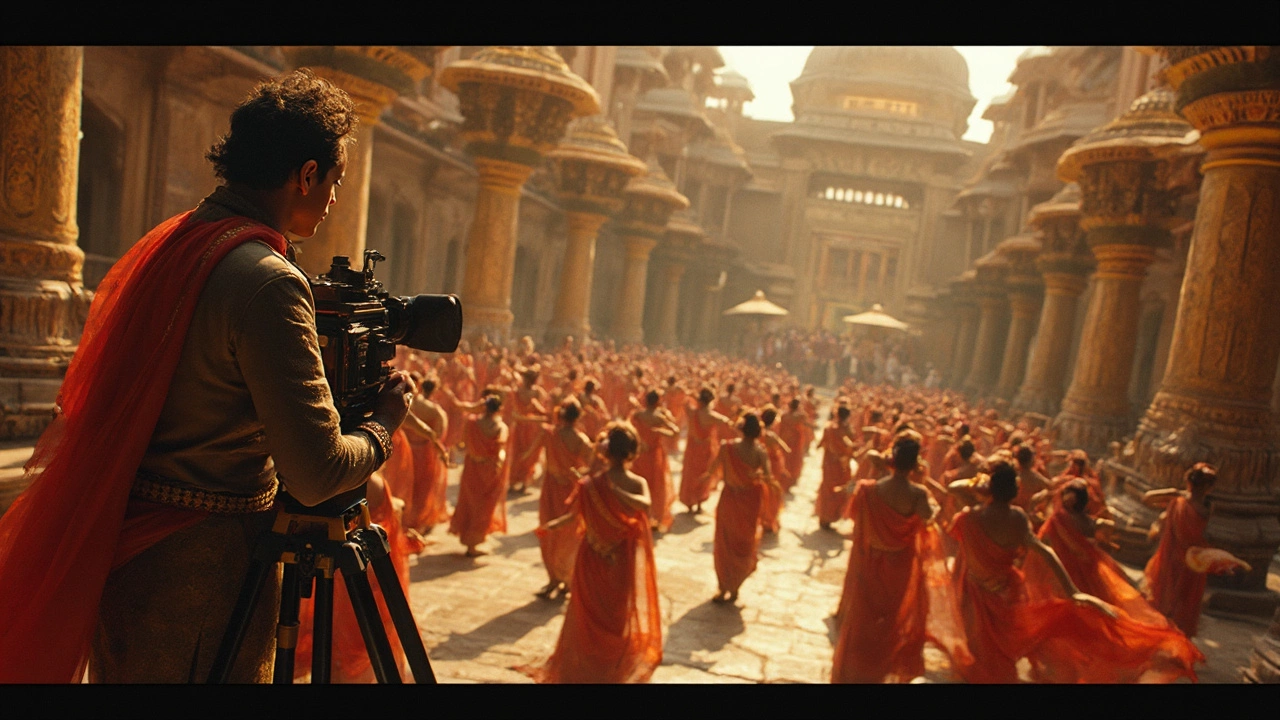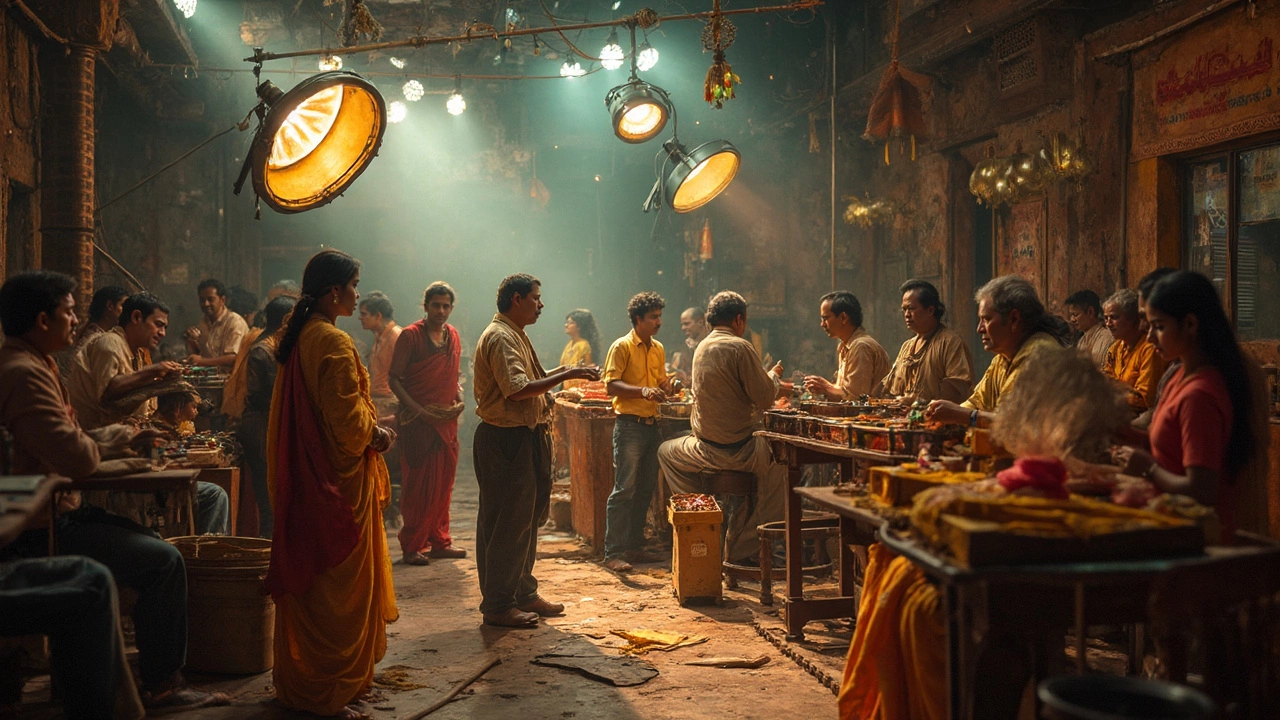Costliest Movie in the World: A Dive into Classic Indian Films
 Feb, 8 2025
Feb, 8 2025
Ever wondered which flick tops the chart as the costliest in the realm of classic Indian films? You're in for a treat. Let's cut to the chase. Indian cinema, with its rich history and massive audience, has seen some films with jaw-dropping budgets.
Understanding what makes a movie expensive isn't just about big stars or fancy locations. It's a mix of technology, talent, and sheer ambition. In a country where every state has its own film industry, it’s fascinating to see how a single film can stand out in terms of budget.
Take the case of the classic film 'Mughal-e-Azam.' When it was made, it set new records for spending. Why? From elaborate sets that redefined opulence to period costumes that transported you back in time, the movie set a benchmark for grandeur.
- Understanding Movie Budgets
- Historical Context of Indian Cinema
- The Making of Expensive Indian Classics
- Blockbusters and Budgets
- Technological Advances in Filmmaking
- Conclusion: Impact and Legacy
Understanding Movie Budgets
So, what's the real deal with movie budgets? Let's start with the basics. A movie's budget is pretty much the total cash needed to get the film from script to screen. You'd be surprised at what goes into it!
Breaking Down the Costs
First off, there's the 'above-the-line' costs. This means things like story rights, salaries for the main actors, directors, and producers. For classic Indian films, these figures can be pretty high, especially when dealing with iconic stars.
Next, you've got 'below-the-line' costs. This is all the technical stuff – crew salaries, equipment rentals, sets, and locations. In Indian cinema, films like 'Baahubali' brought in new tech and visual effects, really bumping up the budget.
Marketing and Distribution
Don't forget about the money spent on getting the movie out there. Marketing can sometimes cost just as much as the film itself! Posters, trailers, and events during the release are essential.
Why So Much?
Lots of factors make a movie costly. Think about the scale of historical or fantasy genres. Big sets, special effects, and detailed costumes quickly add up. That's why films like 'Mughal-e-Azam' remain legends for their unparalleled expenditure.
| Expense Type | Percentage of Budget |
|---|---|
| Above-the-Line | 30% |
| Below-the-Line | 50% |
| Marketing | 20% |
Understanding these components gives you a clear view of how some Indian classics became the costliest movies of their time. It's not just about throwing money; it's about making every rupee count to create something unforgettable.
Historical Context of Indian Cinema
Indian cinema has a colorful and dynamic history that reflects the country's cultural diversity. It all began with the silent film 'Raja Harishchandra' in 1913, directed by Dadasaheb Phalke. This movie marked the inception of what's now a colossal industry.
By the 1950s, often called the golden era of Indian cinema, filmmakers like Satyajit Ray and Raj Kapoor were creating films that gained international acclaim. During this time, movies not only entertained but also addressed social and political themes, resonating with audiences across different classes.
Golden Age and Beyond
The 1960s and 70s saw the rise of new genres and storytelling styles, pushing the boundaries even further. With Bollywood taking center stage, names like Amitabh Bachchan and Lata Mangeshkar became household names. This period also saw a huge increase in the production budgets, setting the stage for the multi-million-dollar Indian films we see today.
The 1990s brought technology into the picture. Digital sound, improved special effects, and international collaborations started making a mark, allowing bigger and more costly projects to flourish. The emphasis on grandeur and detail began to appeal to global sensibilities, further boosting budgets.
Budget Milestones
The evolution in the cost of making a film is evident when we look at the budgets over the decades. From humble beginnings to staggering amounts, the trajectory has been steep but fascinating.
| Decade | Average Budget (INR) |
|---|---|
| 1950s | 1-5 million |
| 1970s | 5-20 million |
| 1990s | 50-100 million |
| 2010s | 500 million+ |
The skyrocketing budgets have their roots in technological advancements, high production values, and an ever-expanding audience that's hungry for diverse content.
The Making of Expensive Indian Classics
Diving into the creation of classic **Indian films**, it's like stepping into a whole world of creativity and ambition. But hey, it's not all glam and glitter. These films carry a price tag that could make your head spin.
This all boils down to a few crucial ingredients. Beyond the cameras rolling and actors delivering lines, let's break down where the money really goes.
Star Power and Payouts
The leading heroes and heroines in Indian cinema draw crowds like bees to honey. In films like 'Kabhi Khushi Kabhie Gham,' massive star-studded casts meant more cash flow for the stars. It’s not just about having famous faces; it’s about who fits the role and can pull the audiences to theaters.
Sets That Amaze
Some Indian classics made their mark with jaw-dropping sets. 'Mughal-e-Azam', anyone? It’s like they built a mini kingdom overnight! Those dreamy palace visuals didn’t come cheap. The craftsmanship in set design added a hefty chunk to the cost. But the results were worth it, setting new standards globally.
Music and Dance: The Heart of India
No Indian film is complete without its music. Songs like 'Pyar Kiya To Darna Kya' became iconic. Hiring famous music directors and choreographers ensured tunes that were timeless, but it wasn’t just about the melodies. The intricate dance rehearsals and lavish sets for songs ramped up production costs significantly.
Visual Effects and Innovations
Even back in the day, when CGI wasn't the buzzword it is now, films like 'Sholay' did wonders with action sequences that demanded innovations. Blasting trains and using pyrotechnics required both creativity and cash. Nowadays, with advancements in technology, these costs are often redirected towards special effects, making them the most visually captivating films.
Mixing Tradition with Modernity
Classic films often strike a balance between age-old storytelling and modern techniques. A film like 'Baahubali', though not exactly from the classic era but flavored with traditional elements, showcased how blending these aspects can draw worldwide attention while being heavy on the wallet.
Here's a quick look at how budgets break down:
| Element | Approximate Percentage of Budget |
|---|---|
| Actor Salaries | 30% |
| Set and Costume Design | 25% |
| Marketing and Promotions | 20% |
| Special Effects | 15% |
| Miscellaneous (Music, Crew, etc.) | 10% |
These percentages might vary, but they give you an idea of where the big bucks are often spent in making an **Indian film** that becomes a cultural pillar.

Blockbusters and Budgets
When we think about blockbuster Indian films, it's impossible not to wonder about their mammoth budgets. For instance, movies like 'Baahubali' and 'Padmaavat' have wowed audiences not just with their gripping stories but also with their sky-high production costs.
The budget of a movie isn't just a random number. It includes everything from hiring big-name actors to building massive sets. In the case of 'Baahubali', the two-part epic spent over 250 crores INR (about 34 million USD), making it one of the most expensive films in Indian cinema history. Those towering waterfalls and epic battle scenes didn't come cheap!
Special Effects and Technology
In recent years, Indian films have ramped up their use of visual effects and cutting-edge technology. This shift has significantly impacted movie budgets. '2.0', starring Rajinikanth and Akshay Kumar, went all out with its special effects, shelling out around 450 crores INR (over 60 million USD), which makes it not just a costly Indian film but one of the priciest globally.
Why so much on effects? As audience expectations rise, filmmakers use advanced CGI to deliver a more immersive experience. This means more action, more drama, and yes, bigger budgets.
Star Power
Star-studded casts mean big bucks. Actors like Shah Rukh Khan, Aamir Khan, and Deepika Padukone can command hefty fees due to their immense popularity. In fact, a substantial chunk of a movie's budget often goes to compensating these actors, which is why they are seen as bankable assets for the film's success.
Ultimately, the cost of making blockbuster Indian films reflects the scale and ambition involved. As technology and talent evolve, so do the possibilities—and the price tags—of producing these cinematic marvels. It's a fascinating era for movie enthusiasts, with budgets that reach new heights year after year.
Technological Advances in Filmmaking
When we talk about technology in Indian cinema, it’s like entering a whole new world. The advances have not only changed how movies are made but also how we experience them. Especially in the costliest movie category, technology plays a massive role.
Back in the day, Indian films were heavy on practical effects. But as technology evolved, so did the art of filmmaking. Many classic Indian films, even from the era of the '60s and '70s, began incorporating advanced techniques to push boundaries. For instance, the classic 'Mughal-e-Azam,' originally shot in black and white, was colorized decades later using digital technology, creating a renewed cinematic experience.
Emergence of CGI and VFX
Today, CGI and VFX are game changers. They help in creating those extraordinary scenes that are otherwise impossible. Take 'Baahubali: The Beginning' as a contemporary example, though not classic, it showcases what modern technology can achieve. The breathtaking waterfalls and epic battle scenes were a combination of stunning locations and advanced VFX work.
High-Definition Cameras and Digital Filmmaking
The shift from analog to digital cameras has revolutionized the industry. High-definition cameras offer better image quality, more filming flexibility, and can significantly cut production costs. Films that used to take months to shoot now often wrap in a fraction of the time without losing quality.
Sound Design and Editing Software
Good sound design can make or break a film. With software like Pro Tools and Logic Pro, filmmakers now have the power to create immersive soundscapes that pull audiences right into the story. These are crucial elements in making an expensive movie feel worth every penny invested.
Technological advances keep breaking new ground in filmmaking, allowing directors and producers to dream bigger and create more spectacular experiences. As technology continues to evolve, it's exciting to think about where it'll take Indian filmmakers next.
Conclusion: Impact and Legacy
When looking at the costliest movie in the sphere of classic Indian films, the legacy they leave behind is as vast as the budgets they command. These films aren't just about money; they're about creating cultural landmarks that resonate through generations.
Take 'Mughal-e-Azam,' for instance. This film not only broke financial limits but also transformed storytelling in Indian cinema, blending rich historical narratives with stunning visuals. Its impact was profound, not just in terms of artistry, but also as a benchmark for future productions.
Long-Lasting Influence
Films like these often lead to innovative technologies and craftsmanship within the industry. The use of new filming techniques and elaborate sets showed filmmakers the power of visual storytelling. This pushed the boundaries, encouraging daring and inventive approaches to film production.
Moreover, they continue to inspire a new generation of filmmakers who see beyond the financial aspects, understanding the true value these classics hold in combining passion, creativity, and cultural storytelling.
The Ripple Effect on Audiences
Audiences, too, play a significant role in the legacy of these films. Their reception can turn a high-budget film into a timeless classic, appreciated not only for its production values but for its ability to connect with people's emotions and histories.
In summary, while the costs might raise eyebrows, it's their enduring legacy that makes these films unforgettable. They have shaped the panorama of Indian films, leaving an indelible impact on narrative and visual art.